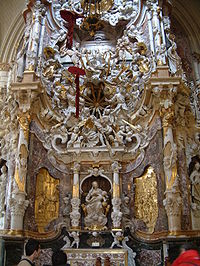
El Transparente
Encyclopedia

Baroque
The Baroque is a period and the style that used exaggerated motion and clear, easily interpreted detail to produce drama, tension, exuberance, and grandeur in sculpture, painting, literature, dance, and music...
altarpiece in the ambulatory
Ambulatory
The ambulatory is the covered passage around a cloister. The term is sometimes applied to the procession way around the east end of a cathedral or large church and behind the high altar....
of the Cathedral of Toledo
Cathedral of Toledo
The Primate Cathedral of Saint Mary of Toledo is a Roman Catholic cathedral in Toledo, Spain, seat of the Metropolitan Archdiocese of Toledo....
. Its name refers to the unique illumination provided by a skylight in the vault above. It was created in 1729-1732 by Narciso Tomé
Narciso Tomé
Narciso Tomé was a Spanish architect and sculptor of the late-Baroque or Rococo period.Born in Toro. With his brother, Diego, he sculpted in 1715, the facade of the University of Valladolid...
and his 4 sons (2 architects, 1 painter and 1 sculptor). The use of light and of mixed materials (marble, bronze, paint, stucco) may reflect the influence of Bernini's Cathedra in St Peter's, Rome.
Its execution was ordered by Diego de Astorga y Céspedes
Diego de Astorga y Céspedes
Diego de Astorga y Céspedes was an Spanish Cardinal of the Roman Catholic Church. He also served as Bishop of Barcelona, Archbishop of Toledo and Grand Inquisitor.- Biography :...
, Archbishop of Toledo. The Bishop wished to mark the presence of the Holy Sacrament with a glorious monument. The monument costed 200,000 ducat
Ducat
The ducat is a gold coin that was used as a trade coin throughout Europe before World War I. Its weight is 3.4909 grams of .986 gold, which is 0.1107 troy ounce, actual gold weight...
s and motivated great enthusiasm, even with a poem wherein the monument was acclaimed 'the Eighth Wonder of the World'. Cardinal Astorga y Céspedes is buried at the feet of 'El Transparente'.
According to American writer James Michener's book Iberia (1968), the Transparente was installed to allow light to pass from the ambulatory behind the high altar (or 'reredos' as he calls it), onto the tabernacle (container for the Blessed Sacrament) which stayed in constant shadow because of the tall reredos.
Not only was a hole cut into the top of the back thick wall of the cathedral above the ambulatory behind the high altar, but another hole was cut into the high altar itself to allow a shaft of light to come down to illuminate the tabernacle like a spotlight.
After the 2 holes were cut, Tomé and sons designed a way to connect the 2 by sculpting a company of angels, saints, prophets and cardinals. A mass of angels and clouds disguises the hole that allows light through the hole in the back of the high altar. Abstract designs of robes and foliage masked the architectural piercings that were made so the hole in the back of the altar is hidden from the viewer.

